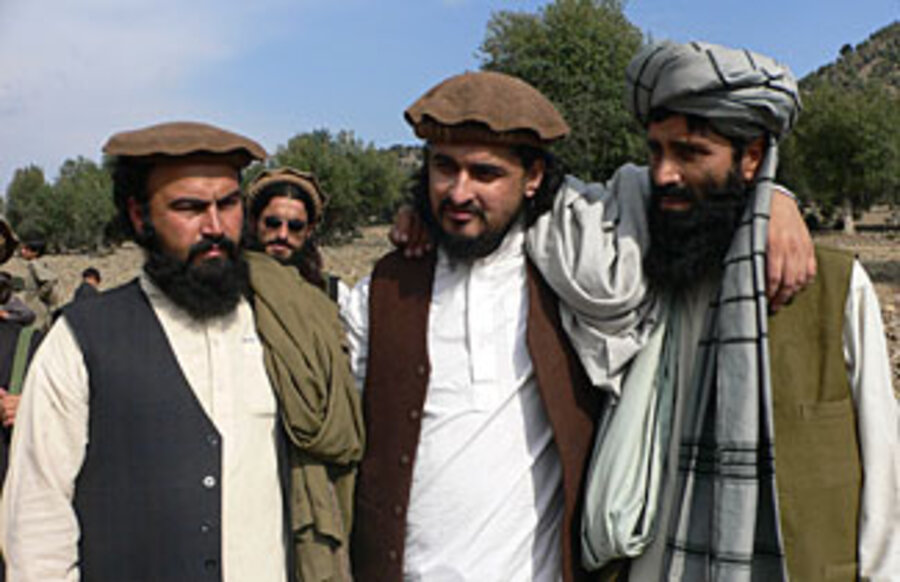Pakistan Taliban's new leader shows he's in charge
Loading...
| Lahore, Pakistan
The reemergence of Pakistani Taliban leader Hakimullah Mehsud after weeks of speculation that he might be dead was nothing if not emphatic. At a press conference in his South Waziristan base Sunday, the heir of Baitullah Mehsud appeared alongside four top Taliban commanders, including the rival whom the Pakistani government said had killed him.
At the press conference, which was broadcast on Pakistani television Monday, Hakimullah boasted that the Taliban is stronger than ever, vowed to defeat America and the Pakistani army, and denounced President Barack Obama and his Pakistani counterpart Asif Ali Zardari as "enemies of humanity."
Its airing coincided with a suicide bomb attack on the United Nations World Food Program offices in Islamabad that left five personnel dead and more than eight injured. On Tuesday, the Taliban claimed responsibility for the attack through spokesman Azam Tariq.
"This sends out the clear message that he's in charge, the infighting is over, and they would like to portray that they are as potent as ever," says Talat Masood, a retired Pakistani army general and security analyst based in Islamabad.
Posing for the cameras
With his reputation as bold and brash, Hakimullah Mehsud shows none of the signs of camera-shyness that marked his predecessor, Baitullah. In Monday's video he posed for the cameras, smiling, surrounded by heavily armed deputies. He looked noticeably chubbier than in older photographs.
Also noteworthy is the young leader's sense of showmanship and timing, says Rahimullah Yusufzai, the Peshawar bureau chief of The News, an English daily. "Instead of responding immediately to [Interior Minister] Rehman Malik's taunts to show himself if he was alive, he bided his time and made his appearance on his own terms," he says.
Beyond the timing, the press conference also showcased a Who's Who of top militant figures. Standing beside Hakimullah were erstwhile rival Waliur Rehman, and Qari Hussain, a cousin, referred to as "teacher of suicide bombers."
Most surprising to the five reporters who made the two-day journey to Hakimullah's hideout was the presence of Qari Zafar, who had gone into hiding and is wanted for his alleged involvement in the 2006 bombing of the US consulate in Karachi that killed four people, including a US citizen.
Hakimullah riffed on familiar themes. At one point he played on public fears of a growing US presence in the country, mentioning the planned expansion of the US embassy in Islamabad and claiming that members of the American security firm formerly known as Blackwater, notorious for its aggressive behavior in Iraq, were prowling the streets of Islamabad and Peshawar.
He affirmed his relationship with Mullah Omar, leader of the Afghan Taliban, threatened a fresh wave of suicide bombers, and said the Pakistani Taliban would end its war with the Pakistani military only when they were allowed free rein to cross the border and fight the US in Afghanistan.
An intelligence failure or a look-alike?
The manner of Hakimullah's comeback is likely to embarrass the Pakistani government and intelligence agencies, which earlier claimed that the leader had been killed by rival Waliur Rehman in a shoot-out over succession in August. Part of this confidence had been based on a negative result of a voice-analysis test conducted on a phone call that Hakimullah had made to news agencies after the alleged shoot-out.
It's cause for concern as an intelligence failure, says Rahimullah Yusufzai, Peshawar-based journalist for The News, a Pakistani newspaper. "It shows they are depending too much on secondary sources, and don't have their own people on the ground. They are relying too heavily on anti-Taliban sources who are biased anyway, and some may have their own agenda."
But Interior Minister Malik cast doubt on whether the man at the press conference was really Hakimullah or his look-alike brother. This view is backed by Mahmood Shah, a former security chief for Pakistan's Tribal Agency, who believes the "impostor" has a rounder face than the real Hakimullah, though others say the militant has simply gained weight.
Masood, the analyst, sees encouraging signs from Hakimullah's press conference as well, especially ahead of the military's planned offensive into South Waziristan. "His offer to open up negotiations shows they fear a major ground operation in their base, they would like to avoid this," he says.
Many analysts agree that despite Monday's attacks, the Pakistani Taliban have not regained the operational strength they had when the iconic Baitullah Mehsud was in charge. They also say that the military's recent success against the Taliban in the Swat Valley has weakened the militant network there.
Says Masood: "It's important to strike while the iron is still hot."





